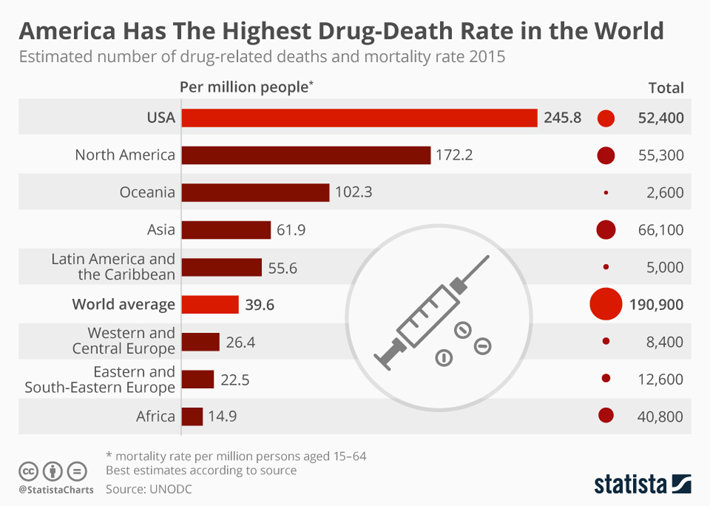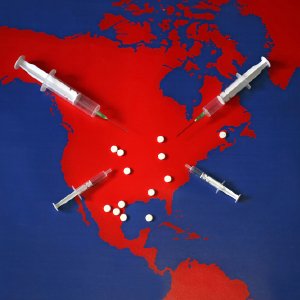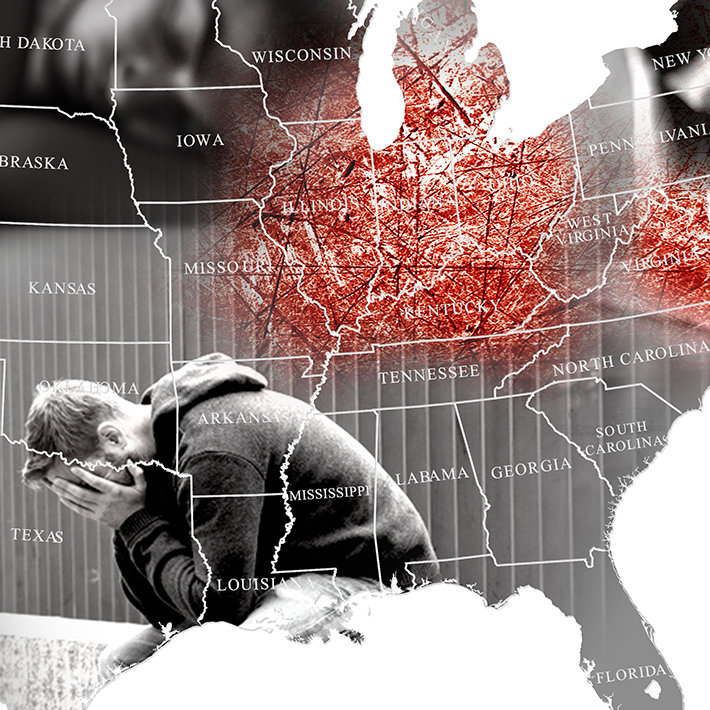Drug Overdoses Compared to Other Countries

I went a few years without listening to the radio. Premium memberships to online streaming stations, why bother? But a few days ago I was driving across the state, coincidentally through an internet dead zone. I thumbed the dial on my car’s stereo and settled in for the long haul on a local station that was playing, “The greatest hits from the 80s, 90s, and now.”
As I listened to some of my generation’s best attempts at pop rock, I couldn’t help but notice that several of the commercial breaks had an advertisement about a toll-free hotline for treatment center referrals. If it wasn’t that, it was a local, rural clinic that offered help for substance abusers, a crisis line for struggling addicts, a support hotline for the family members of addicts, etc.
I don’t remember hearing ads like these on the radio several years ago. Has addiction gotten that bad? Apparently. But I shouldn’t have been all that surprised. I read articles about the subject often enough, and I write some of them, too.
When I got home, I did some light research to see what the mighty internet had to show me on how the U.S. drug problem compared to that of other nations. I found one research project that showcased the overdose deaths of the United States and a dozen other randomly selected countries. The United States was at the top of the charts by a significant margin.
How the U.S. Matches Up to Other Nations in Drug Overdoses

The research project was completed by the National Institutes of Health’s National Cancer Institute, and it was published in the Annals of Internal Medicine. The goal of the research? To determine the extent of drug deaths in the U.S. and to gauge the severity of that death rate when compared to 12 other countries.
Summarized information on the research project can be found for free and with no subscription at CNN. Free membership to the Annals of Internal Medicine grants access to the research text itself.
The countries examined were the United States, Denmark, England, Chile, Argentina, Estonia, Australia, Germany, Mexico, Finland, Norway, the Netherlands, and Spain. The research examined the total number of overdose deaths for each nation and then compared those numbers to various public health factors, law enforcement policies, treatment access, and a bevy of other circumstances in each country.
Here’s how the numbers worked out for drug overdose fatalities in 2015:
- The United States – 51,039 deaths.
- England and Wales – 3,323 deaths.
- Germany – 2,147 deaths.
- Australia – 1468 deaths.
- Spain – 625 deaths.
- The Netherlands – 435 deaths.
- Norway – 375 deaths.
- Finland – 325 deaths.
- Mexico – 312 deaths.
- Denmark – 256 deaths.
- Estonia – 95 deaths.
- Chile – 81 deaths.
According to Dr. Yingxi Chen, one of the researchers, “The U.S. has the highest death rate due to drug overdoses for both men and women (35 deaths in 100,000 men and 20 deaths in 100,000 women) in 2015, more than double those of any other country in our study.”
Compare that to Mexico, which only has one drug death per every 100,000 men and just 0.2 deaths per 100,000 women. The research project also found that the U.S. had an increase in drug deaths by 4.3% per year for men and 5.3% for women. Compare that to a country like Norway, which is currently experiencing an annual reduction in their drug overdose deaths, not an increase. Amazing.
The research was careful not just to examine the number of drug deaths for each nation, as the populations for the countries examined varied considerably. Instead, the researchers explored deaths per capita, percentile increases in drug deaths, etc. (I just have to make a quick note here. Let’s not forget though that the sheer number of drug deaths in the U.S. is significant. Almost 64,000 dead from drug overdoses in 2016 and over 72,000 dead from drug overdoses in 2017, according to the National Institute on Drug Abuse).
But Why Is Our Nation’s Drug Problem So Lethal?
The research points an arrow at opioids for being the primary reason for such rampant overdoses in the U.S. According to the research; opioids are the U.S. “triple threat”, as it were. This is because the opioid epidemic started with a lethal wave of prescription opioid drug abuse in the late 1990s and early 2000s, it advanced into fatal heroin abuse in the mid-2000s, and now the epidemic is focused on deadly synthetic opioid misuse in the 2010s.
Our great nation is mired in an opioid epidemic—one we’ve been unable to shake for almost a quarter of a century. Opioids are the single most significant factor in the rampant increase in drug overdose deaths that we see every year.
The U.S. Insists on Continuing Various War-on-Drugs-Era “Solutions” Which Don’t Work
You’d think we’d have gotten the message by now. Whatever we’re doing, it’s just not working. The “War on Drugs” is failing, has failed, and will continue to fail. You can’t take a criminal stance against addiction and substance abuse, you just can’t. It doesn’t work.
“An effective strategy (for substance abuse) needs to establish realistic objectives and criteria for evaluating success or failure, and must focus on reducing the death, disease, crime and suffering associated with both drug use and drug policies.”

Quoted in Harvard Law Today, Ethan Nadelmann, the head of the Drug Policy Alliance, says that “If we’re lucky, our grandchildren will recall the global war on drugs of the late 20th and early 21st centuries as some bizarre mania. An effective strategy (for substance abuse) needs to establish realistic objectives and criteria for evaluating success or failure, and must focus on reducing the death, disease, crime and suffering associated with both drug use and drug policies.”
The war on drugs meets none of the above criteria, and instead reaches a cruel, decades-old punitive stance that wasn’t even workable when Richard Nixon first declared war on drugs in 1971.
Help Addicts Get Better and Prevent Addiction – A Clear Path to Fewer Drug Deaths
I tend to take Ethan Nadelmann’s stance on much of what he says. Will we ever create a civilization that is entirely free of addiction? Maybe so, maybe not. But as we work towards that goal, we have to implement strategies that work. We have to break away from a 48-year-old dogma that was flawed, to begin with.
If we’re going to move away from being one of the top nations in the world for drug abuse, we have to focus on helping people get better from drug addiction, and that doesn’t happen in a jail cell. It happens in an inpatient addiction treatment center.
And we have to focus on preventing addiction too, by educating our youngsters on the harms and risks at hand with drug and alcohol experimentation. If we do all of that then maybe we’ll leave a sober nation to our kids. Maybe then, when I’m tootling around going ten miles under the speed limit as an elderly man, I won’t hear drug treatment advertisements when I turn on the radio. I can only hope.
Sources:
- https://www.cnn.com/2018/11/12/health/us-high-overdose-rates-study/index.html
- http://annals.org/aim/article-abstract/2714295/premature-mortality-from-drug-overdoses-comparative-analysis-13-organisation-economic
- https://www.drugabuse.gov/related-topics/trends-statistics/overdose-death-rates
- https://today.law.harvard.edu/feature/war-drugs-succeeding/
- https://www.britannica.com/topic/war-on-drugs
Reviewed and Edited by Claire Pinelli, ICAADC, CCS, LADC, RAS, MCAP


